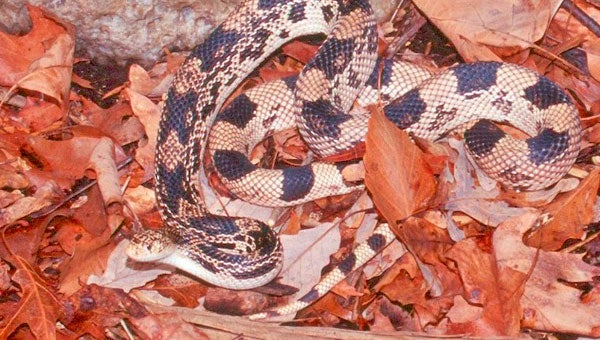Polk County’s Most Wanted: Northern Pine Snake
Published 10:07 pm Wednesday, July 24, 2013

The photo is of a Northern Pine Snake. (photo by John White, Virginia Herpetological Society; submitted by Pam Torlina)
This week’s species in our continuing series of articles on ‘Polk’s Most Wanted’ is the Northern Pine Snake (Pituophis melanoleucus melanoleucus.)
The Northern Pine Snake is one of the largest snakes in North Carolina, with specimens routinely reaching lengths exceeding 4 feet. On rare occasions, the Pine Snake may reach 6 feet in length. These snakes are bulky in appearance, with an overall background coloration of whitish-gray, with black or brown blotches. In some areas, Pine Snakes may be referred to as ‘Bullsnakes’ due to their resemblance to that species. True Bullsnakes, however, occur west of North Carolina. The Pine Snake should not be easily confused with any other type of snake in N.C.
Pine Snakes are non-venomous and completely harmless to humans. However, if cornered or accosted, these snakes are capable of putting on an impressive threat display that includes very loud hissing, inflated throat and striking repeatedly. Unfortunately, such displays often result in the death of the Pine Snake at the hands of uninformed persons.
Pine snakes are usually active in the early morning hours, or late afternoon. Higher temperatures at mid-day oblige these large serpents to seek shelter underground in the burrows of mammals or in the interiors of hollow logs or tree stumps. Northern Pine Snakes will mate in the spring, and the females will deposit between five-15 very large eggs.
Northern Pine Snakes are most abundant along certain areas of the Coastal Plain and in the Sandhills region of N.C. This is not surprising, as these areas contain the open Pine forests and dry, sandy soils in which this species prefers to burrow. The habits of Northern Pine Snakes in the Piedmont and Mountains are shrouded in mystery.
Encounters with this species in the western areas of our state are very rare. However, Pine Snakes are an extremely secretive species and spend the majority of their time underground.
The Northern Pine Snake is not known to occur at Polk County – yet. At the present time, reports of the Northern Pine Snake in North Carolina are confined to the following counties: Brunswick, Cherokee, Clay, Cumberland, Graham, Harnett, Hoke, Montgomery, Moore, New Hanover, Richmond, Rutherford, Scotland and Swain. Some of these reports are many decades old. Also of interest are credible sightings of Northern Pine Snakes just south of the N.C. state line, along the S.C. Hwy. 11 corridor. Therefore, the most likely areas for Northern Pine Snake to be found in Polk would be the southern edge of the county, particularly along the south-eastern boundary adjacent to Rutherford County (N.C.) and Spartanburg County (S.C.)
Much remains to be learned about this harmless and secretive species in North Carolina, particularly in the Piedmont and Mountains. Alert citizens can aid greatly in this regard by reporting any sightings of this snake to the appropriate authorities. Those with information concerning Northern Pine Snakes in Polk or nearby counties are encouraged to contact the Pacolet Area Conservancy.
If you think that you have seen this species or know where it might be located, contact PAC at 828-859-5060, or e-mail comments, questions or photos to, landprotection@pacolet.org.
The purpose of this project is to gain a better understanding of the flora and fauna in Polk County and document the species present in the county.
PAC is a 501(c)(3) non-profit conservation organization (land trust) founded in 1989 to Protect and Conserve the area’s natural resources (PAC’s mission.) PAC works with area landowners to ensure the long-term protection of their property through voluntary conservation easements (agreements) which enable landowners to maintain ownership of their property, preserving precious natural resources (open lands, forests, wildlife habitat, scenic vistas, farmland, stream banks, etc.), and potentially obtain significant federal, state and local tax benefits.
PAC’s vision is a community living and growing in harmony with our natural resources and or goal is to provide a legacy that will endure and be valued by generations to come. PAC works diligently to provide leadership to encourage conservation and provide education programs emphasizing native species appreciation and responsible land use practices to help – save the places you love.
– article by David Campbell




